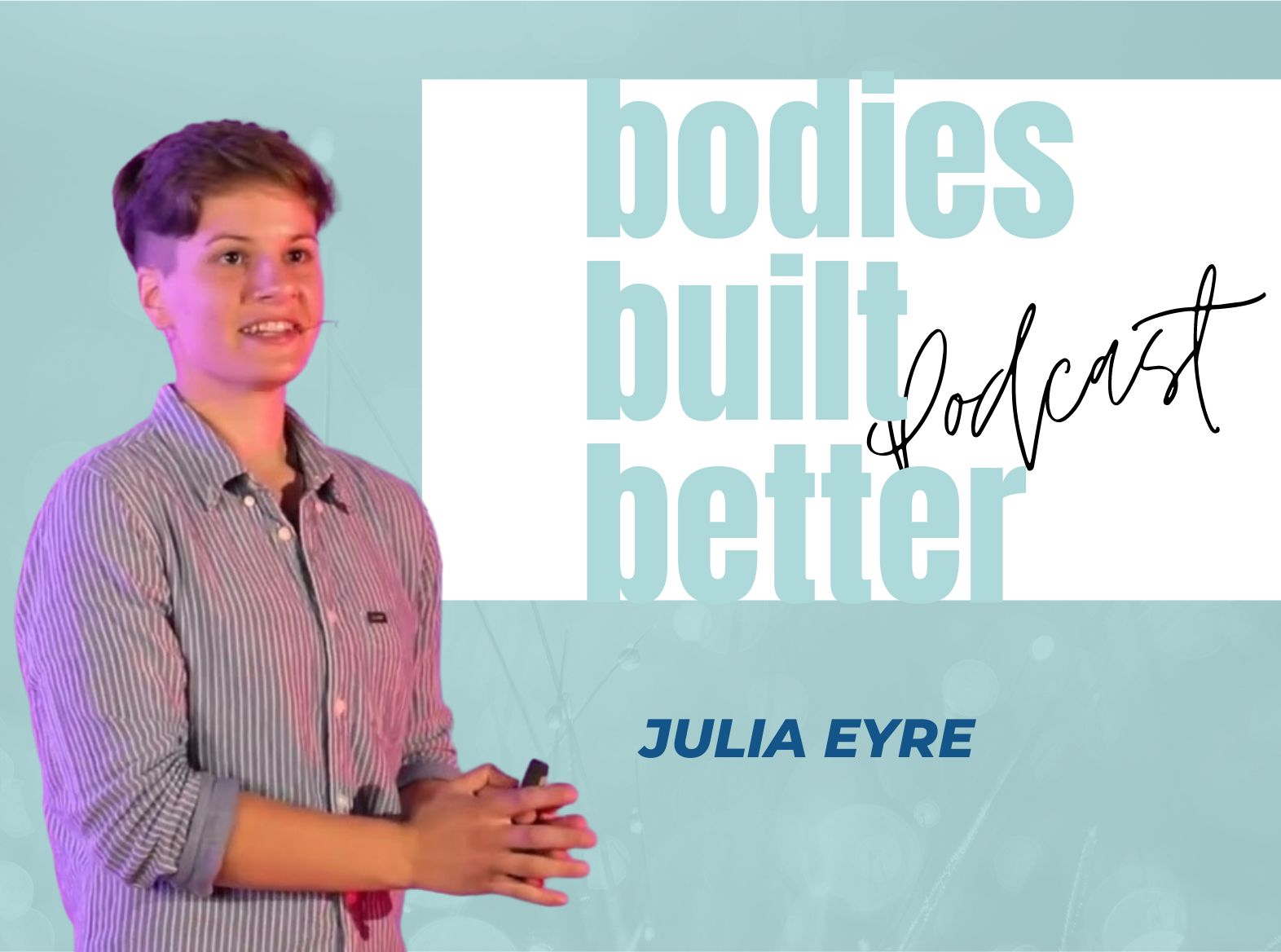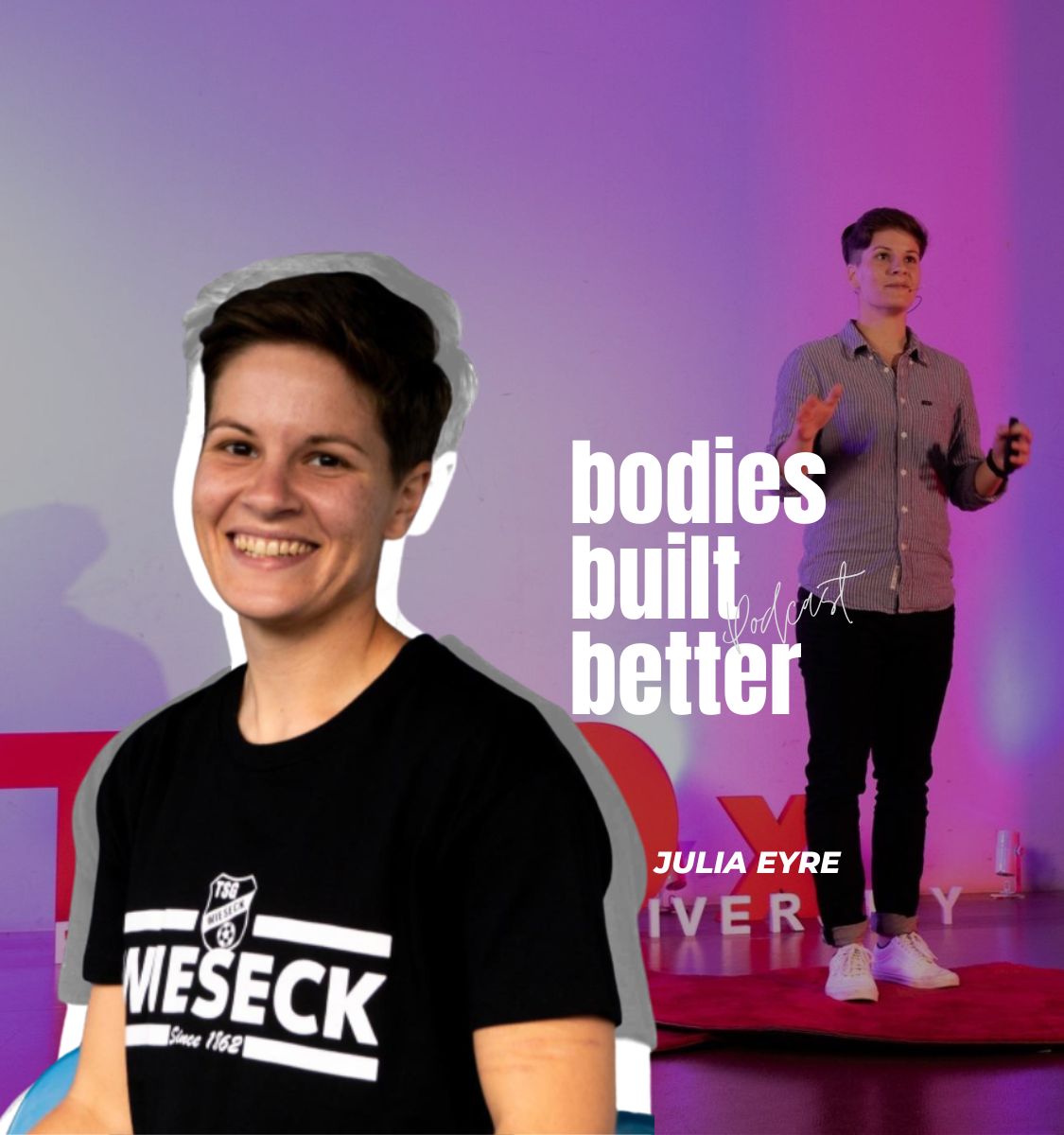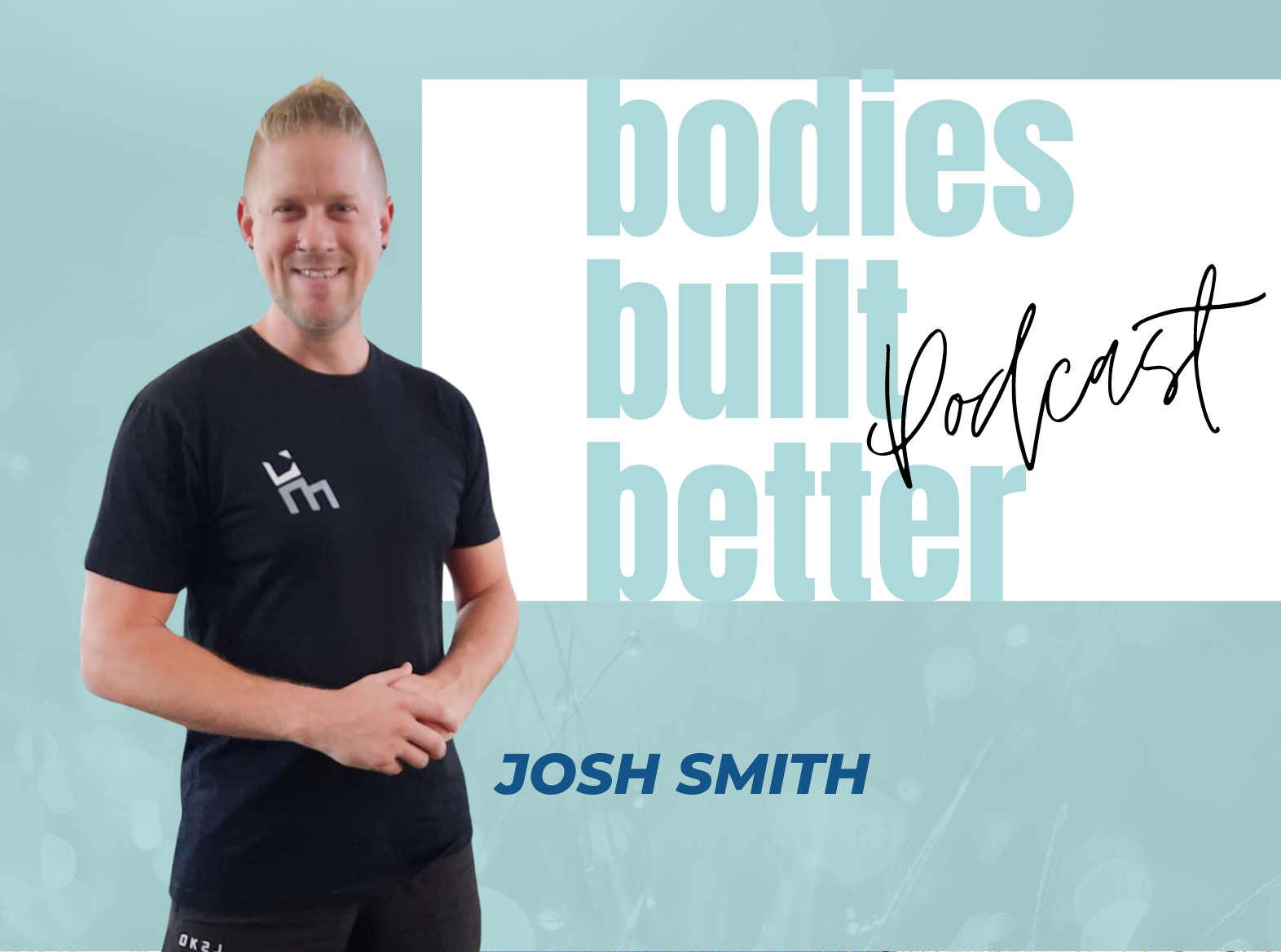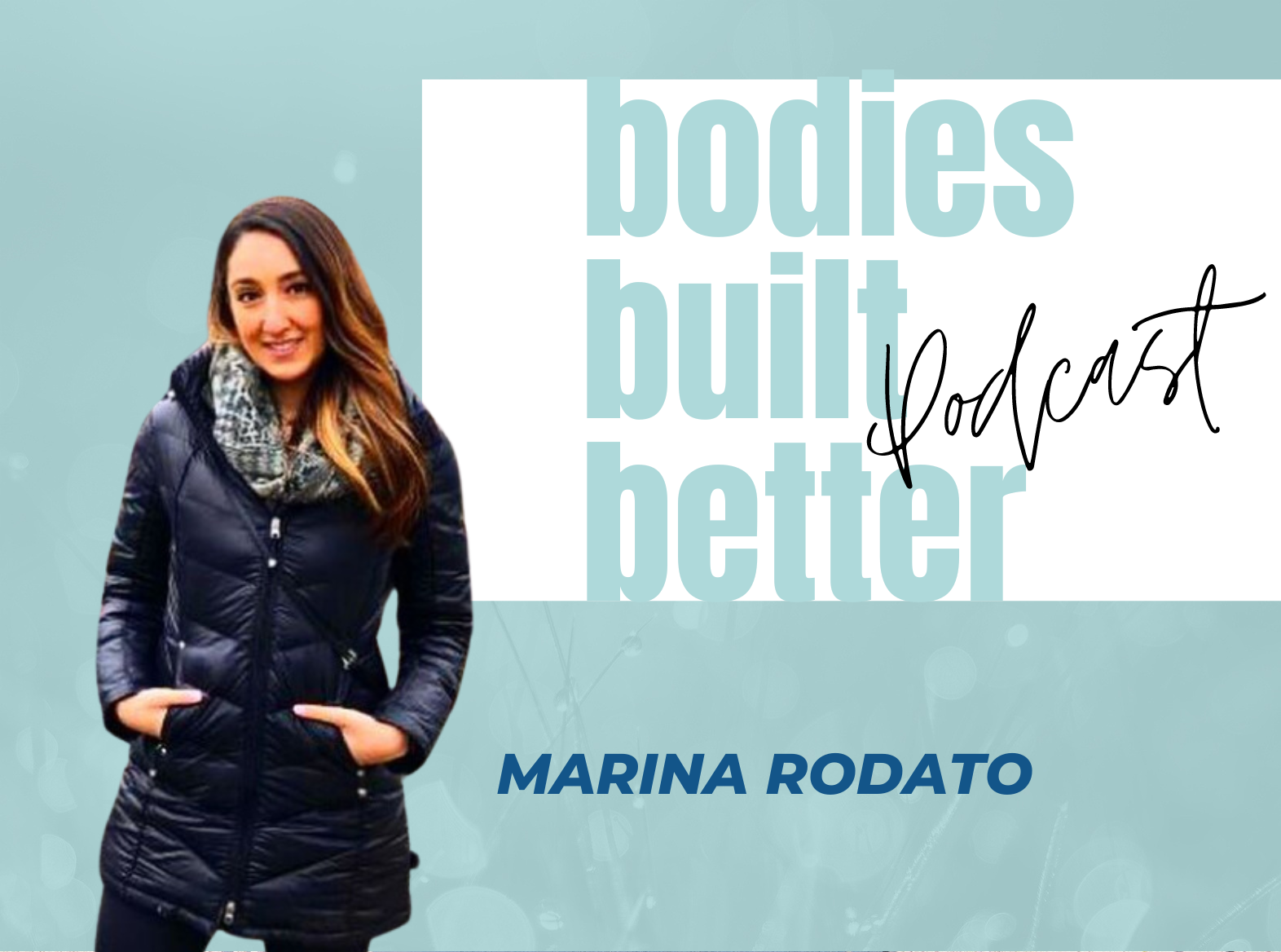An Introduction to Julia
Jackie 2:19
Julia, thank you so much for chatting with me today. Welcome to the Bodies Built Better podcast.
Julia 2:26
Jackie, thank you so much for inviting me. I’m excited to be here. Let’s share the mic. Let’s get–
Jackie 2:32
Let’s do this. Well, firstly, I’ve been following you for a little while now. And I love your training, philosophy and methods. And I recently watched your TEDx talk, which Firstly, congratulations, TEDx is huge. So that’s massive to start off with. But I loved your talk, building a complete athlete. And I think it’s so important for athletes, to hear, for coaches to hear, and also to parent, for parents to hear of kids who want to be, you know, taking their sport seriously and moving through, you know, that develop developmental stages. And I think, yeah, what you’re talking about is so important, and we’re gonna dive deeper into that today. But before we do, I’d love to get to know a bit more about you how you got started in this industry and how it’s evolved into what you’re currently doing.
Julia 3:39
Oof. Good. Start with easy questions first.
Jackie 3:44
Who are you?
Julia 3:46
Right, exactly. That’s the one I had to think about the most Damn, okay. Well, I’m Julia. I’m German-American, very aggressively, actually. Depending on what tend–what type of day you catch me on, and what time of day even better, get me in the morning where it’s still cool. Usually aggressively German around two or three o’clock in the afternoon when it starts getting, you know, really, really warm, now that summer, it’s, like aggressively, “I wish we had air conditioning,” everything is. “Open up all the windows!” More seriously, though, I am a sports scientist and a psychologist.
The Intersection Of The Brain And Body
Julia 4:21
I’m working basically at the intersection of the brain and the body. So I sit right there and on top of the neuro-nervous system and try to give coaches as well as athletes and other psychologists and medical professionals insights into what it’s like working with the athlete as a human first as opposed to an athlete or a player in their sport like a sports specific player, and why it’s important to actually focus on the development of that person, and how that then stems into performance enhancement like being able to have fun, being able to be healthy at all, and protecting the fun and protecting the time that you bring with your sport that actually leads to a better performance at the end of the day. But it’s difficult to have an unhappy athlete who is also not healthy then perform well over time. And so I really sit at that intersection of trying to educate people through psychoeducation and bringing in neuroscience, but also giving more specific skills as like, we need to be focusing on recovery, we need to be focusing on stress management, we need to be focusing on everybody going to therapy, we need to focus on coaches helping us sports psychologists because there’s not enough sports psychologists to fill the need. So that’s yeah, those are the intersections that I sit on. It’s fun. I have my own company. and, and we, White Lion Performance, is that, a consulting company, coaching company that works then with the athletes directly, implementing that and helping them learn that. And then through psychoeducation, teaching coaches and consulting with Federations in clubs as well how to do that. So it’s kind of like an extension of my arms, of this holistic caring for the entire athlete, putting the person before everything else, just simply because there’s not enough sports scientists who think that way. There’s not enough psychologists working with athletes to do that. So giving us the skills where I can.
The Importance of A Recovery Baseline
Jackie 6:16
Yeah, and you, you do it so well, as well. Like, it’s so important, like you said that, that recovery aspect of an athlete’s regime, like you said, if you’ve got a, an athlete who is not doing well, mentally, emotionally, that’s going to come out in their performance. So it doesn’t matter how much you train them physically. You won’t be getting the best out of them anyway.
Julia 6:44
When we start on the basis of “How’s your recovery, how’s your fitness baseline? How’s your recovery baseline?” as opposed to “How’s your performance?” we start getting different answers, and then we can start building the performance from there as opposed to having to pull back and focus on building recovery. First, we start with the recovery, it’s the must have, that’s the prerequisite. And now we can build the load and performance on top.
Jackie 7:07
Yeah, cool. And you said recovery baseline, like, how do you–how do you find what the baseline is for your athletes? Where do you start?
Julia 7:18
Great question. So for anybody watching, my recovery baseline has to have a French press right next to me at all times to fill up my coffee cup. For other people that might look like sleeping eight to nine hours a night, or going out with their friends twice a week, instead of you know, having practice five days a week, having time where they’re not thinking about their sports. So when we talk about recovery baseline, we talked about basically the, the optimal position that we can go out from in being a, as fully recovered as possible athletes. So how’s my well-being doing? How’s my energy? How’s my mood? What are my symptoms? Like, do I have any depression symptoms? How’s my mental health? Do I have any anxiety? How are my stress levels overall? How’s my communication with my coaches? Am I you know, is there peace and harmony? Those are also serious factors that contribute to our wellbeing and to our recovery baseline. Because if you’re not living in harmony with your team, if you’re not, you know, if you’re stressed out, because your thought you’re hard on the ropes, hard on the rocks with your coach or something like that, it’s really hard to get a good recovery score, and even get to the point where we can add tonnes of load on top of you or really even push you because you just can’t recover sufficiently. So when we talk about a recovery baseline, like I said, we’re talking about well being all together. And my perception of how I’m doing so maybe I haven’t slept those nine hours, but I slept seven. And I’m feeling really good because I’m energised, having been around my friends over the weekend, or spending time with family, or I just got through an exam and I had one or two days off. So now I’m feeling awesome because my brain was able to reset itself. So even though I haven’t gotten my sleep all the way up, my recovery baseline is still high. Because I was able to compensate with some other things. And so it’s not as simple as having these three factors. And they all need to be on 100%. It’s more like 10, 12, 15 factors that are always context specific to the person. And then looking at the trends. How recovered are you? How’s your well being doing? And hopefully it’s trending up and with that we can definitely work with that.
Sport Psychology And Technology
Jackie 9:31
In saying all of that, do you work with, I mean, there’s so much technology out there at the moment, the Whoop, Oura Ring, any sort of watch that you can wear that’ll tell you your heart rate variability, your sleep, all of this stuff. Do you work with that as well and really taking that type of data, as well as obviously that perceived recovery from the athlete.
Julia 9:57
It is, it’s really fascinating. What technology is doing, because the technology is not all the same, right? So I wear whoop, Oura a little bit more aerobic based, and I’m not a super aerobic athlete, if I’m being totally honest with you. So I leave that to the runners and the professional soccer players, and I stick to the Whoop where, you know, you can wear this when you’re lifting, it just sits on your wrist. But we’re not looking at the same data. It’s not collecting all the same data, it doesn’t use all the same metrics, and they’re not all accurate. So having different levels of accuracy, these degrees of variability, it’s difficult to say, you know, if we don’t all have one device. Hey, even though you know, you have an Apple Watch, I have a Whoop. And the other three people have Oura Rings, and the other two are just tracking based on perceived feeling. How do we get any degrees of accuracy from that, right? So I tend to go with perception and any external load data that we can get our hands on. So for my athletes, we’re talking about external load being what they’ve done during the week. So their reps, their sets, the weight that they’re doing, you know, if we’re doing a five by one back squat, and then they sprint two days later, and then they play two days after that, I’m going to assume they’re probably going to be pretty tired that week, or over the course of those five days. And then having that external data plus the internal data, for example. HRV is one thing that I always love to work with, if I can get that from somewhere, sleep data, and then perception of stress and mood, and any pain or soreness scores, because that can really tell us a lot about what’s going on as well. And the combination of those things, is how I can get like a recovery score or wellness score or a fitness score from an athlete, but having them, having said that, it’s difficult when one sends me a screenshot from their Apple Watch that says I burn 3000 calories in the session, and then one from the Whoop that where they built burn 250. And it’s all over the place. So the technology is not uniform enough for us. So we kind of have to work off a combination of that. I love it. I’m glad that we have it. We’re further than we were 10 years ago, but it’s still a little bit confusing, because it’s just not uniform. We can’t work with all of them at one time.
Working With Heart Rate Variability
Jackie 12:12
Yeah, yeah. And you mentioned HRV, heart rate variability, how do you use that in, in your training with the athletes?
Julia 12:21
So a lot of my athletes have Whoop, as I do, and it just gives you a HRV score for your night. So you’re not getting it during training, anything like that. It’s obviously great. If you have a heart rate belt, a polar strap, or a Garmin, something like that, where you can get an HRV score all the time. But what we’re looking for is HRV as a measure of how our basically, autonomic nervous system is doing, so our autonomic, our autonomic functioning. So the lower it’s going to be means we’re not getting those big, beautiful waves in the night, though, that time between breaths. And that’s the time when we are basically optimised for recovery or our best time to recover. So that’s just giving us a general idea of when you are asleep. What’s your stress, like anyway? What’s your recovery, like, anyway, when we’re not able to perceive? You know, we’re not awake, we’re not conscious, being able to think,” Oh, I’m so busy” or “Oh, I’m so sore.” But we are getting those, that nervous system data. And that’s for me, obviously, as a neuroscientist, the fun stuff, because then I can look at how do we optimise your sleep now in order to get a bigger score, what factors go into getting you a bigger score. And HRV is one of those things where I don’t really have a lot of people who say, Oh, my HRV was 85 last night, but I feel like shit, you know, like, but when their HRV is 32 then they’re like, I feel like shit today. I don’t feel recovered at all. So that’s one of those things that really does line up well with our perception of recovery and wellness. So I do like using HRV just as a general. Here’s how we know how you’re doing. It’s not a trading metric. It’s a recovery metric telling us how the nervous system is doing very, very generally. It looks like you did pretty well last night. Or it looks like you weren’t, what, what factors can we optimise for tomorrow?
How To Optimise Sleep
Jackie 14:10
Yeah, brilliant. And you said you did mention optimise sleep, how, how do you go about optimising sleep with your athlete.
Julia 14:19
So one big thing is trying to buy them 30 to 60 more minutes of sleep a lot of times because that can make a huge difference just for the mental clarity. If they’re cognitively just not they’re able to get a grip or that soreness that just cannot go away being able to buy them an extra hour of sleep or for my athletes who are menstruating are getting ready to menstruate especially as well we see the HRV change in flux as well with that depending on symptomology so it might just be something where hey, can you please figure out how to allow yourself to get in bed 60 or full 60 minutes early or tack on 60 minutes on Saturday where I know you have another hour of sleep so that we are getting, you know, catching up to some extent on recovery. It’s really hard to catch up on sleep, we don’t actually believe that you can do that sufficiently, maybe to about 30%. But more, it’s difficult to catch up or make up for sleep that you’ve lost. So here and there, trying to push an extra hour of buffer on top of that is important. The other is when we’re travelling, still making sure that things are dark, that you’re able to get into that nocturnal mode of shutting down, not too much screen, not too much light. And sometimes introducing white noise in the night can be super duper helpful as well. If there’s lots of stuff going on, if somebody has a restless brain, then that’s my, right up my alley as the psychologist where we might need to talk about some things or implement some, like more specific stress management stuff like what are your specific coping mechanisms? Do you just kind of let it rattle off in your brain and then get lost in this? This toilet cycle of going down the drain? Kind of, or how can we get in front of that, because sleep is really interesting. It’s physical and mental. Of course, there’s a lot of cognitive factors that play into that, and then the environment as well. So it might be environmental, it might be physical, it might be mental and emotional. But the impact that it has even just an extra 60 minutes of sleep, massive, and sometimes that can, that can really save us before tough weekends, tough matches, tough weeks. So anytime it just goes on to quality quantity over the quality sometimes.
Jackie 16:30
Yeah. And do you, are you ever able to adjust what you’re doing throughout your training? Because you said, you know, you try and tack on that 60 minutes, whether it’s in the evening, or whether it’s in the morning of Saturday, or wherever you can find it. But if you can’t find the sleep somewhere, because let’s just say they’re the it’s the next day is game day. How do you how do you work with that? What protocols do you take to really set them up for game or race or whatever it is.
Julia 17:05
So the next thing you get, if the next day is game day, then obviously we really have. But if for example, it’s maybe we got there on a Thursday, they had trouble sleeping overnight, and then Friday, we would theoretically have our last training session, and then Saturday, we would play so if we’re looking at sleep over those two days, we obviously still want to be able to push them but knowing that they’ve had bad sleep Thursday night, and then Friday night as well, I’m probably going to pull them out and lower their volume, maybe not intensity, but definitely crank back the volume on Friday. Which, it shouldn’t be a tonne of volume anyway, then the night before match or the day before a match. But make that really just a priming session where the nervous system is getting going, if I can maybe, getting them cognitively involved, and then completely removing them cognitively from football or swimming or whatever their sport is like, please go take some time off. Here’s your two to three hour block where I don’t want to hear from you, don’t think about me, don’t think about football or whatever the sport is again, and then be able to turn off and mentally prepare however they best can having done less volume, but still keeping up the intensity because for me intensity, always approaching everything with intensity is really, really important. Like that sense of urgency. At the same time. Like I said, it’s still really hard to do anything if you don’t have adequate sleep. So then we’re really going to look at okay, afterwards, how can I get you completely knocked out and horizontal going on going into Sunday because I need you to recover. And then we’re looking at how we can reduce injury risks after that as well. If we need a recovery session the day after the match as opposed to a strength training session. That’s also okay.
Sport Psychology Strategies For Mental Health
Julia 18:53
But my job, primarily because I’m not a head coach in any sport, is just the damage control and making sure that the recovery stays up. So the athletes are even able to perform. Because the load that they go through in professional sports is unreal. And the scheduling, timing, travelling and stress is unreal and so half the time I just feel like my job is damage control. Okay, you’re super tired. Here’s what we’re gonna do about that. All right, you’re super sore and have that ongoing soreness and it’s looking like it’s turning into a, maybe a muscle issue that’s gonna stick around. What do we do about that? Is just jumping into control, damage and get the best out of the circumstances that we have. Yeah, it was not optimal at all.
Managing Thoughts And Behaviours
Jackie 19:36
Yeah, well, that’s it. I, you, you mentioned before, you know that person who has so much going on in their head and obviously that will affect sleep. I can relate because I’m all up in my head a lot of the time. How do you mask and this is true. This is a soft society these days. So, how do you manage that with your athletes? What what do you do?
Julia 20:06
Okay, so one trick that really helped for me is from Marsha Linehan, who is the, one of the fat Well, the founder of dialectical behavioural therapy. So DBT. And it’s actually a therapy form, used a lot for people who struggle with or have borderline personality disorder, also bipolar, etc. But they’re literally just tools to use in your brain. For example, when you start spinning in the cycle, ask yourself before you get lost, always try to come back to the first thought, like, what was the first thought that started the cycle? And how did I get all the way down there? It doesn’t matter how I got there at the end of the day, but come back to the first thought, because remember, that was the one that mattered like you had that one for a reason. And then the rest kind of followed along. But what was the first one? Okay, that’s probably the one that’s causing the most stress because obviously, it’s sent you down this, this road, just deal with that one, it’s just the one. The other thing is for people who tend to have too many thoughts at once, and just get completely overwhelmed as opposed to going down one train of thought. And catastrophizing is remembering that our thoughts are literally just like popcorn, our brain just be throwing shit out, like, hello, pop, pop, pop, pop. And then when we grab one and hold it tight, now we’ve made it a permanent thought, whereas it was just going to fall back down and disappear under the, the other popcorns, you know, it’s just going to blend in, it wasn’t that important, there was nothing that actually set it apart. So a lot of times, especially if we’re already stressed out and primed to think I don’t want to be embarrassed tomorrow or something like that, then we have a thought about embarrassment. Now we’re going to hold that one really tight, as soon as you catch that thought hold it really tight. And now we’ve made it permanent, but it wasn’t permanent before. So being a little bit more open handed with thoughts and practising the mindfulness of, I’m just going to let them pop, pop pop, and observed from over here and not judge them or hold them tightly, is really important can be really, really helpful in competition as well, because it’s the same thing, you know, I made that mistake, but I’m not going to hold it tight, I’m just going to let it go. Or, you know, the athlete was able to turn the play, the other team was able to turn they scored. I’m not gonna hold it tight, I’m just gonna let it go. So being able to learn how to play with basically an open hand, an open palm, is really helpful. And that starts in, as soon as you get those thoughts jumping into your head, just thinking, I’m not going to hold it tight. It’s just popcorn, I’m gonna let it go, fall, disappear. And then it moves on. Because emotions and thoughts aren’t permanent, either. They last for a couple seconds, maximally a couple minutes, and then they’re gone. It’s us that cement them then into our brain and into our lives.
Jackie 22:39
Yeah. And so if you grab hold on one of those thoughts, it’s just about recognising that that’s what you’ve done and, and somehow let it go like–
Julia 22:51
Yeah, we’re gonna try and let it go. The thing is, is once you’ve grabbed onto it, we’ve kind of cemented it as well, right? So that’s the problem. And so it’s more getting ahead of that and learning how to as soon as those thoughts come up, stepping back from the peanut gallery and being like, it’s just a gallery, there’s a glass wall in between, none of these things are permanent. And they’re also not dangerous. Like, they can’t attack you, they cannot, they’re in your brain. What are they going to do? You know, it’s just the thought it’s actually not dangerous. The same thing as a feeling, an emotion is also not dangerous, even if it feels incredibly threatening. Being able to just let it go and be like, Okay, I’m gonna take a step back from this. And observe it from afar. I’m not in it right now. So being able to create that amount of distance makes it a lot easier to just be able to let the thought go.
Building The Complete Athlete
Jackie 23:40
Yeah. Incredible. You did. Give us a little bit of insight into in your introduction about building a complete athlete. Can you break that down for us into a little bit more detail? What does that mean?
Julia 24:01
My TED Talk URL is–
Jackie 24:04
Exactly. Don’t worry, there’ll be links to that.
Julia 24:08
I’m sure but no, there’s, it’s really simple. There’s three phases and it’s a triangle. So the first level is the very bottom. The foundation of the triangle is the athlete. The second or sorry, the first one is the human the second one is the athlete right smack in the middle and then up on top is the player. And the sport industry tends to work from like the top only in the athlete in the player at the end best case scenario. But in most scenarios, if we’re being entirely honest, it’s just about the player because we come in as I don’t know a soccer player and you just are a soccer player. And you don’t get to be thoroughly developed athletically before becoming a soccer player or developed as a human before becoming an athletes before becoming a soccer player. So incomplete in creating this complete athlete. Yeah, methodology. It’s impressive. written that the human is always considered first and foremost, including when it’s coming down to who’s injured, who’s fit, who can play, this athlete is injured. Let’s think about the long term effects of this as well. And not just are we going to win on Sunday. But also, if this athlete has a concussion from three days ago, if they get another concussion on Sunday, because we let them play early, we’re looking at a serious problem that’s going to affect them for the rest of their lives. Making considerations like that. And then also, you know, even the dumb, small things like this athlete is super stressed out from school, how do we make allowances for this athlete to also be able to study but also train and also play, even if it means only playing for 45 minutes, or maybe only training twice instead of three times this week, because if they don’t pass this exam, they’re not going to graduate. And if they don’t graduate, they’re not going to be able to study, you know, thinking about the long term as well. And not just the athletes while we have them and what they can do for us now.
Why The Athlete Comes First
Julia 26:00
That’s why we talk about the athlete comes first. Because that’s always or the player, the human comes first, because that’s always in our mind, then develop them athletically on top of that, so that they can play other sports, they can move well, they’re not in pain. When I say hey, I’m done playing basketball, I want to go play volleyball now. That’s cool, you just changed, you just switched out on top, you know, decapitated basically the peak of the pyramid and said, I’m a volleyball player, now instead of a basketball player and learn a new set of sports, specific skills, but my coordination, my strength, my endurance, my flexibility, my speed, all of those things were already developed, because that’s under category athlete. Just like my intelligence, my personality characteristics, my life, my hobbies are under a category human, which is at the very bottom. And that’s the base of all things. And without those things, we don’t really have the emotional and cognitive development plus the physiological like athletic development, to support a long term sports career. Because there’s nothing under or beyond that player category that, hey, I’m a striker, or hey, I’m a point guard, or, Hey, I swim freestyle. Beyond that, I don’t really have anything. So if we then look at after a career, it could be, you know, a professional athlete who retires at 35 with 10 gold medals from the Olympics, or it could be a player who drops out when they’re 17, with an injury before going to college out of you know, the travel league locally. What are they going to do after that? And what are they taking with them? It wasn’t a good experience to or did it damage them significantly? are we sending them out worse than they were when they started? Or are we leaving them better than we found them basically better than when they came into the system? Are they more developed? Are they better? Can they take something good with them, and speak well of this time, as opposed to having been severely damaged and needing to spend the rest of their lives building back their physicality, or taking care of injuries or going to therapy or whatever, that should never be the case, we should be looking out for their well being from day one. Because they came into us as humans, and they’re gonna go out as humans as well, regardless of what happens in the meantime.
Where To Find Julia
Website: www.whitelionperformance.com
Instagram: @whitelionperformance
Tedx Talk: https://www.youtube.com/watch?v=OeWfgYkijV0
you Tube: https://www.youtube.com/channel/UCeGED0WdcDDDiumlxt5QKuw
If you enjoyed this episode of The Bodies Built Better Podcast please hit SUBSCRIBE and share it with your friends.
Head over to The bodes built better podcast page – https://jackietann.com/the-bodies-built-better-podcast/
Follow @jackietann_rmt and @bodiesbuiltbetter on Instagram
Got questions, comments, or feedback? Get in touch via the above social media handles.







